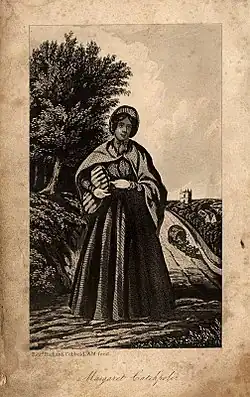Margaret Catchpole
Margaret Catchpole | |
|---|---|
 A portrait of Catchpole dating from the 1840s, painted from memory by Richard Cobbold | |
| Born | 14 March 1762 |
| Died | 13 May 1819 (aged 57) Richmond, New South Wales, Australia |
| Occupation(s) | Servant, nurse, cook, midwife |
Margaret Catchpole (14 March 1762 – 13 May 1819) was an English servant girl, chronicler, and deportee to Australia. Born in Suffolk, she worked as a servant in various houses before being convicted of stealing a horse and escaping from Ipswich Gaol. Following her capture, she was transported to the Australian penal colony of New South Wales, where she remained for the rest of her life. Her entry in the Australian Dictionary of Biography describes her as "one of the few true convict chroniclers with an excellent memory and a gift for recording events".
Early life
Catchpole was reputedly born at Nacton, Suffolk, the daughter of Elizabeth Catchpole[1] and according to one source of Jonathan Catchpole, head ploughman.[2]
Catchpole had little education and worked as a servant for different families until being employed in May 1793 as under-nurse and under-cook by the writer Elizabeth Cobbold at her house on St Margarets Green in Ipswich.[3] Cobbold's husband was a brewer and member of the prosperous Ipswich Cobbold family. Catchpole was close to the family and was responsible for saving the lives of children in her care three times. She also learned to read and write while employed by the Cobbolds.[1]
According to Percival Serle's Dictionary of Australian Biography (1949),[2] she once rode bareback into Ipswich as a child to fetch a doctor, guiding the horse with a halter. The source also says that she had fallen in love with a sailor named William Laud, who had joined a band of smugglers; later, he was pressed into service in the Royal Navy. Serle says Laud once tried to persuade Catchpole to travel in a boat with him when another of her admirers, John Barry, came to her assistance, and a fight ensued; Laud shot Barry. Barry recovered, but a price was put on Laud's head.[2]
Criminal conviction

In mid-1795, Catchpole left the Cobbolds and became ill and unemployed.[1] After being told by a man named Cook that Laud was back in London, Cook persuaded Catchpole to steal a horse and ride it to London to meet her former lover – Cook planned to sell the horse for his benefit.[2] On the night of 23 May 1797, Catchpole stole John Cobbold's coach gelding and rode the horse 70 miles (110 km) to London in nine hours, but was promptly arrested for its theft and tried at the Suffolk Summer Assizes.[1]
According to Serle, Catchpole pleaded guilty at her trial, and after evidence regarding her previous good character had been given, she was asked if she had anything to say about why a sentence of death should not be passed upon her. She spoke with firmness, regretting her fault but not praying for mercy. Even when the death sentence was pronounced, she remained composed until she saw her old father crying in court.[2]
Catchpole's sentence was commuted to transportation for seven years, and she was detained in Ipswich Gaol. After three years, she escaped using a clothesline to scale the 22-foot (6.7 m) wall. Margaret was recaptured on a Suffolk beach and given a sentence of death, which was later reduced to transportation for seven years. She arrived in Sydney on the Nile on 15 December 1801.[1]
Australia
Margaret Catchpole's life in Australia was relatively uneventful. She was assigned as a servant to John Palmer who had arrived with the First Fleet as purser on HMS Sirius and was now a prosperous man. After the death of her lover, Catchpole had resolved never to marry, and in Sydney, she refused the addresses of George Caley. Later she was employed as the overseer of a farm, and while in the country, she became a midwife and kept a small farm of her own. She was happy and respected, and in a letter written to England in about 1807, she wrote, "all my quantances are my betters"—she had little education and her spelling was her own. She was pardoned on 31 January 1814 but did not return to England.[1]
Little is known about the last ten years of her life, but Catchpole continued her nursing and died on 13 May 1819 after catching influenza from a shepherd she was nursing. She was buried in St Peter's church graveyard at Richmond, New South Wales.
Papers
Archival materials relating to Catchpole and her relationship with the Cobbolds are held by the Suffolk Archives, the Ipswich Museum, the National Library of Australia, and the Mitchell Library in New South Wales. Some of her surviving letters are roughly transcribed on the Mitchell Library website and reproduced in Laurie Chater Forth's Margaret Catchpole: Her Life and Her Letters (Richmond, 2012). They are discussed, with excerpts, by Marthe Jocelyn in her Scribbling Women: True Tales from Astonishing Lives (Toronto, 2011).
Catchpole's letters describe Hawkesbury River floods, frontier conflict with Indigenous Australians, the countryside and its wildlife, economic developments such as the use of convict miners at Coal River (Newcastle), and the savagery of colonial manners and customs — "by her writings [she] added greatly to Australia's early history".[1]
In culture
The History of Margaret Catchpole, a Suffolk Girl
Rev. Richard Cobbold (son of her former employers) made Catchpole the subject of a novel, The History of Margaret Catchpole, a Suffolk Girl (London, 1845), which has often been reprinted. While Cobbold says in the preface that "the public may depend upon the truth of the main features of this narrative", he takes some liberties and also gets some things wrong, for example:
- Education: Cobbold's heroine speaks and writes as a cultivated woman, when her letters (see above) show that her education was limited.
- Marriage: He believed Catchpole married in 1812 and had children — this appears to have been a genuine conviction rather than poetic licence; however, there is no record of a marriage, she invariably describes herself as being on her own, and she is unlikely to have started a family at the age of fifty.[2]
- Death: Cobbold maintains that Catchpole lived until 1841; however, the register of burials at Richmond leaves no doubt that she died in 1819: "Margaret Catchpole, aged 57 years, came prisoner in the Nile, in the year 1801. Died May 13; was buried May 14, 1819. — Henry Fulton".[2]
Other appearances
Later works, many of which rely to varying degrees on Cobbold's novel, include:
- 1854: Margaret Catchpole, the Female Horse Stealer!, a popular drama produced in London around 1854.[4]
- 1887: An English Lass, an Australian play by Alfred Dampier and C.H. Krieger, with Lily Dampier as Catchpole in the original production.
- 1911: The Romantic Story of Margaret Catchpole, an Australian silent film directed by Raymond Longford and starring Lottie Lyell in the title role. Only part of the movie survives today.
- 1945: Margaret Catchpole, a radio play by Rex Rienits produced twice by the Australian Broadcasting Corporation: in 1945 with Bebe Scott as the lead and in 1958 starring Alda Ferris.
- 1949: Margaret Catchpole, the Girl from Wolfkettel, a novel by George Goldsmith Carter. Wolfkettel is, or was, a Saxon name for the area around Nacton.[5]
- 1966: The Extraordinary Margaret Catchpole, a novel for children by Ruth Manning-Sanders that concentrates on her life before she was deported.
- 1972: The Smuggler's Wench, a bodice-ripper by Monica Mugan adapted from the Cobbold novel.
- 1974: Margaret Catchpole, a novel for children by Australian author Nance Donkin with illustrations by Edwina Bell, depicting Catchpole as a pioneering convict woman.
- 1979: Margaret Catchpole: Two Worlds Apart, a chamber opera by the English composer Stephen Dodgson with a libretto by Suffolk-based writer Ronald Fletcher, recorded by Naxos in 2019.[6]
- 2007: Scapegallows, a novel by Carol Birch based on Catchpole's experience.[7]
- 2019: "Margaret Catchpole", a song by East Suffolk folk group Honey and the Bear on their album Made in the Aker.
As eponym

- The Margaret Catchpole Public House is situated on Cliff Lane close to the site of the Cobbold Brewery in Ipswich.[8]
See also
References
- ^ a b c d e f g Joan Lynravn (1966). "Margaret Catchpole (1762–1819)". Catchpole, Margaret (1762–1819). Australian Dictionary of Biography, Volume 1. MUP. pp. 215–216. Retrieved 14 March 2008.
- ^ a b c d e f g Percival Serle (1949). "Catchpole, Margaret". Dictionary of Australian Biography. Angus & Robertson. Retrieved 14 March 2008. Not be confused with the Australian Dictionary of Biography.
- ^ J. M. Blatchly, "Cobbold, Elizabeth (1765–1824)", Oxford Dictionary of National Biography, Oxford University Press, 2004; online edition, January 2014. Accessed 15 Jan 2015]
- ^ "Playbill for the Bower Saloon: 1854". Museum of London Prints. Retrieved 16 August 2017.
- ^ "Histoire d'une déportée à Botany-Bay", Revue des Deux Mondes, période initiale, tome 11, 1845, pp. 682-706, at Wikisource. Accessed 10 July 2025.
- ^ Margaret Catchpole: Two Worlds Apart, conducted by Julian Perkins, Naxos Recording 8.660459-61, three CDs. Accessed 10 July 2025.
- ^ Bakewell, Sarah (23 November 2007). "Scapegallows, by Carol Birch". The Independent. London. Retrieved 26 September 2010.
- ^ "Ipswich:Margaret Catchpole". The Suffolk Real Ale Guide. Retrieved 26 September 2010.
Further reading
- Salmonson, Jessica Amanda. (1991) The Encyclopedia of Amazons. Paragon House. Page 51. ISBN 1-55778-420-5